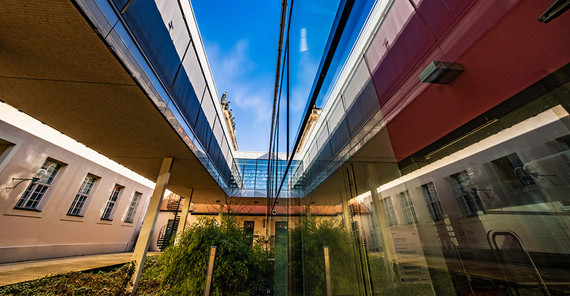How do we collect, manage, and present data on research projects? Which systems are in use in research data and science management? And how do researchers and industry come together for joint projects? Guillem Arrufat brought a lot of questions with him when he came to Potsdam at the end of March. He works in science management at the Universitat Jaume I in the Spanish Mediterranean city of Castellón de la Plana – which is linked to the University of Potsdam through the European University Alliance EDUC. Thanks to close cooperation between the universities involved, Arrufat had the opportunity to visit a number of departments at the University of Potsdam – from the Division of Planning and Statistics to Potsdam Transfer – the central scientific institution for start-ups, innovation, knowledge and technology transfer.
“It was a unique experience,” says the young Spaniard to sum up his visit. “Not just because everyone was so friendly and helpful. I also learned so much from the many visits and gathered important information for myself.”
Guillem Arrufat is actually still a student, in the middle of his master's degree in mathematics. At the same time, he has already been working for his university for a year and a half though, specifically in the Office for Cooperation in Research and Technological Development (OCIT), which is responsible for the administration and promotion of all research and innovation activities at UJI. Arrufat collects data on current research projects and focuses for statistical purposes, but also to initiate cooperation between companies and researchers. “There are a lot of ceramic companies around Castellón de la Plana, with which joint research projects take place regularly. In order to facilitate these and other points of contact, we try to ensure that research information is presented in the best possible way.”
This does not only require diligence, but above all innovation. When he heard about the opportunity to visit Potsdam from a colleague who works in Jaume I University's EDUC team, he simply applied. “I was particularly interested in how information about research projects, patents, scientific publications, research staff and their affiliation to the various departments is collected and presented at the University of Potsdam,” he says.
For his three-day visit, Potsdam’s EDUC team put together a short “round trip” for Guillem Arrufat: to the Division of Planning and Statistics, the Central Division, Potsdam Transfer, the Research Data Management team and, of course, EDUC. “This type of exchange is a great opportunity for networking and for further education and training outside your own university and beyond national borders. However, it is only possible thanks to open and committed colleagues like the ones Mr. Arrufat visited in the various divisions and departments of the University of Potsdam,” says Wiebke Giese from Potsdam’s EDUC team.
“I was welcomed with open arms by everyone,” Guillem Arrufat adds. “One thing that surprised me: Our universities are more similar than I thought. Apart from a few organizational differences, we are dealing with similar issues; Open Science is an up and coming topic. One thing that impressed me: Almost all organizational units have someone who acts as a 'bridge' to the IT department. This leads to greater efficiency.”
Arrufat did not just gain a lot of knowledge and many new insights from his visits, however. He is also enthusiastic about the idea behind EDUC: “I am convinced that this form of cooperation across borders connects us and helps us move forward together.”
More about EDUC at UP: https://www.uni-potsdam.de/en/educ/index
Further education and training opportunities abroad with Erasmus+: https://www.uni-potsdam.de/en/international/profile/erasmus/stt

